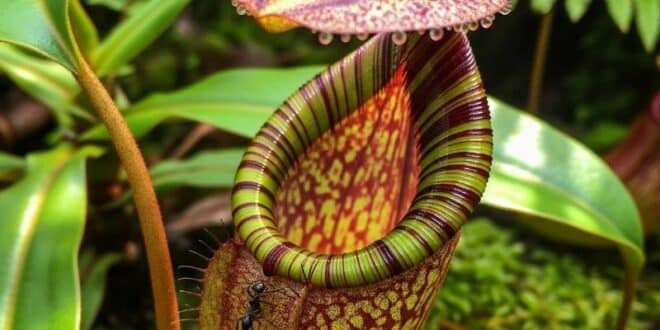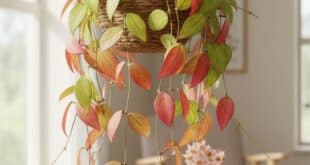Meet The Pitcher Plant
Imagine a plant that looks like something out of a science fiction movie, with cunning “pitchers” that lure and trap insects, keeping your home a little bit bug-free! That’s the astonishing Pitcher Plant! These captivating wonders are unlike almost any other houseplant you’ll meet, making them incredibly intriguing additions to your collection.
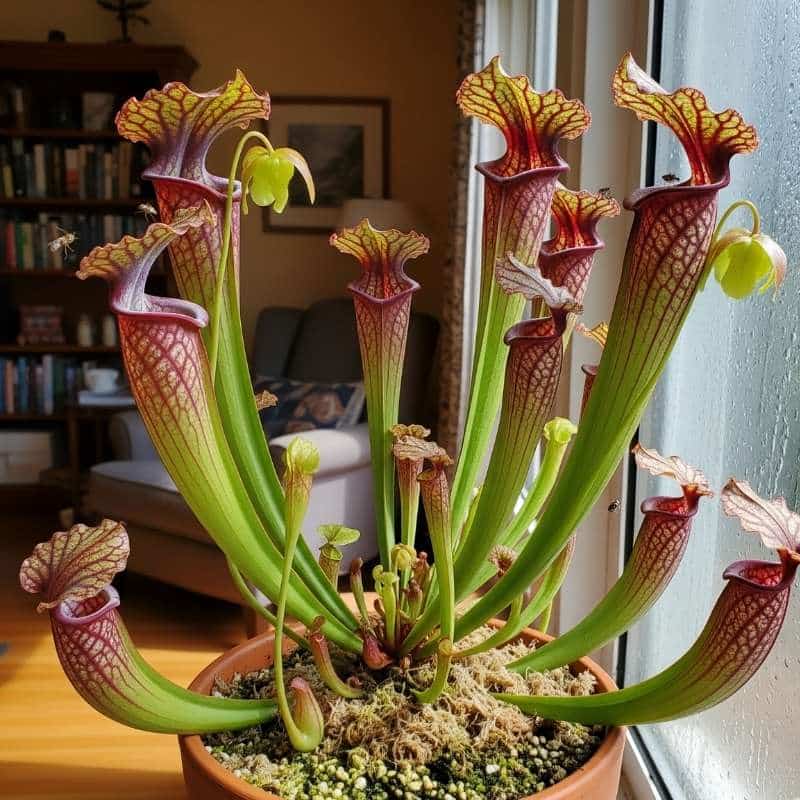
Found across diverse habitats, from the steamy rainforests of Southeast Asia to the boggy wetlands of North America, Pitcher Plants bring a truly unique blend of natural artistry and fascinating carnivorous behavior. They’re perfect for curious plant lovers who want something truly special and a little bit wild! Ready to discover the secrets to keeping these mysterious beauties thriving? Let’s explore how these living insect traps work!
What Makes a Pitcher Plant So Unique? Nature’s Clever Insect Traps!
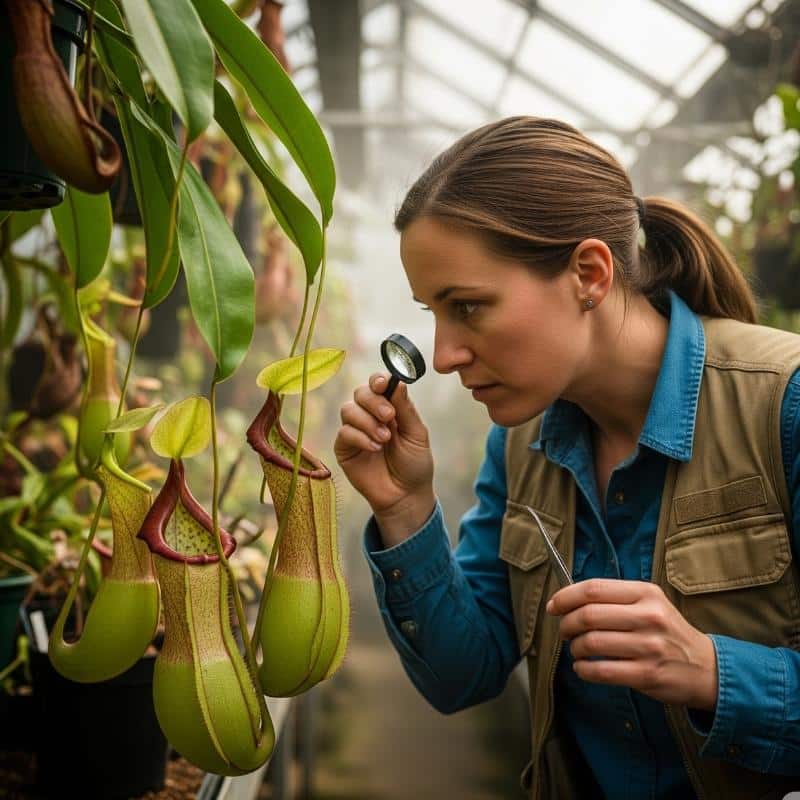
When you look at a Pitcher Plant, its most incredible feature is obvious: its pitcher-shaped leaves! These aren’t just decorative; they’re ingenious traps designed by nature. Here’s how they work:
- Lure: The plant produces sweet nectar or alluring scents around the rim of the pitcher to attract curious insects.
- Slide: The rim of the pitcher is often super slippery, making it hard for insects to get a grip once they land.
- Digest: Inside the pitcher lies a pool of liquid rich in digestive enzymes. Once an insect falls in, it can’t climb out, and the plant slowly digests it, turning it into nutrients.
- Lid: Many pitcher plants have a “hood” or lid (called an operculum) over the opening. This lid helps keep rainwater out so the digestive fluids don’t get diluted, and it can also help prevent larger insects from escaping.
It’s truly a marvel of natural engineering, turning bugs into dinner!
Where Do Pitcher Plants Come From? Global Carnivorous Wonders
Pitcher Plants come from surprisingly diverse parts of the world, which is why their care can sometimes differ.
- Tropical Pitcher Plants (Nepenthes): These beauties mostly come from the humid rainforests of Southeast Asia, thriving in high humidity.
- North American Pitcher Plants (Sarracenia): These striking plants are native to the bogs and swamps of southeastern North America, where they experience distinct seasons.
No matter where they’re from, one thing is common: their natural homes have very poor soil when it comes to nutrients. This is why they evolved to be carnivorous – they eat insects to get the nutrients that aren’t available in their soggy, acidic soil!
What Are Its Other Names? “Monkey Cups” and Their Mysterious Appeal
Tropical Pitcher Plants (Nepenthes) are often called “Monkey Cups” because monkeys have actually been observed drinking the liquid from their pitchers! Their unique, sometimes alien-like shapes and fascinating carnivorous habit give them a truly mysterious and intriguing appeal. They certainly spark conversation! Othe common names are Frog Britches, Huntsman’s Cup
What Kinds of Pitcher Plants Are There?
When people talk about “Pitcher Plants,” they’re usually referring to one of two main groups, each with its own look and slightly different needs. Let’s meet them!
Popular Pitcher Plant Types: Tropical Climbers vs. Bog Beauties
| Type of Pitcher Plant | Key Features | Pitcher Appearance | Growth Habit | Key Care Hint |
| Tropical (Nepenthes) | Wide variety of shapes/colors. Prefer high humidity, warm temps. Most common indoors. | Often hang down from vines. Can be round/bulbous (lower) or slender (upper). Many speckled or striped. | Vining, trailing; pitchers dangle | High humidity, consistent warmth |
| North American (Sarracenia) | Trumpet-like, upright pitchers. Vivid colors (reds, greens). Need a cold dormancy. | Upright, tubular, trumpet-shaped. Often with a ruffled or hooded lid. | Upright clumps from rhizomes | Needs cold winter rest, constantly wet soil |
Pitcher Looks: Shapes, Sizes, and Colors
The sheer variety of pitchers is amazing! They can be short and squat, tall and slender, or elegantly flared. Colors range from various shades of green to vibrant reds, deep purples, and even nearly black, often with intricate speckles, stripes, or contrasting rims. Some pitchers are tiny, just an inch or two, while others (especially in their native habitats) can be large enough to hold a significant amount of liquid!
Growth Habit: Vining/Trailing vs. Upright Clumps
Tropical Pitcher Plants (Nepenthes) are typically vining or trailing plants. Their stems can grow quite long, and the pitchers usually dangle down from the ends of their leaves. This makes them perfect for hanging baskets! North American Pitcher Plants (Sarracenia), on the other hand, grow in upright clumps from a central rhizome (an underground stem), with their trumpet-like pitchers growing straight up.
How Do You Take Care of Your Pitcher Plant?
Caring for Pitcher Plants is quite unique and requires understanding their specific needs. They’re not your average houseplant, but they are incredibly rewarding!
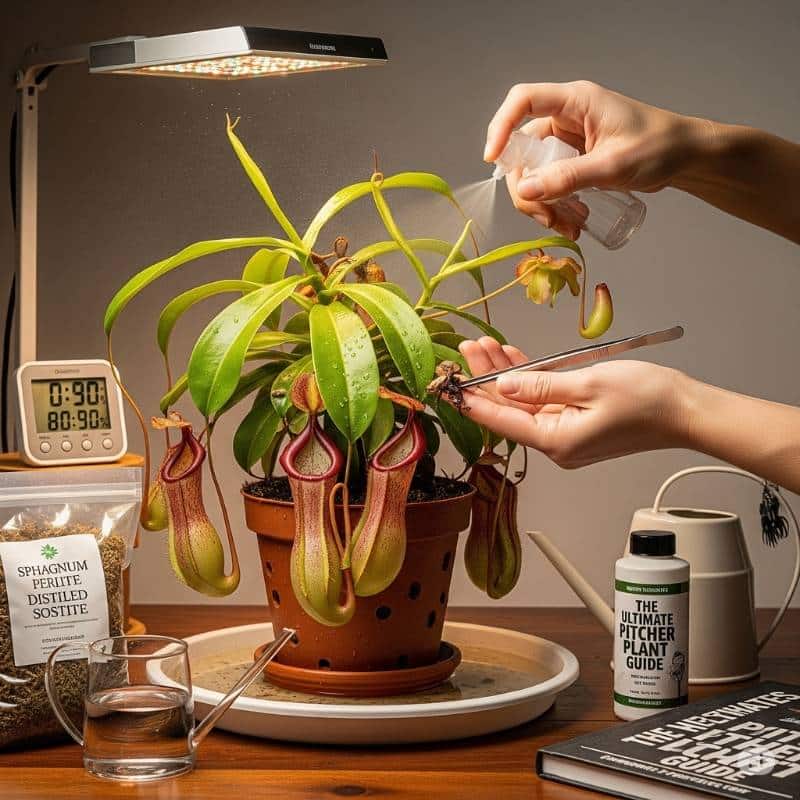
Pitcher Plant Care Summary
Here’s a quick overview of what your unique Pitcher Plant loves:
| Care Category | Tropical (Nepenthes) | North American (Sarracenia) |
| Light | Bright, indirect light (no direct harsh sun). | Very bright, direct sun (at least 6 hours direct sun daily). Needs to be outdoors for best health. |
| Watering | Consistently moist soil, never soggy. Only use distilled/rainwater! | Always wet! Keep pot sitting in 1-2 inches of distilled/rainwater. Needs constant moisture. |
| Soil | Nutrient-poor! Mix of long-fiber sphagnum moss & perlite/orchid bark. No regular potting mix! | Nutrient-poor! Mix of peat moss & horticultural sand/perlite. No regular potting mix! |
| Temperature | Warm, 65-85°F (18-29°C). Avoid cold drafts. | Warm summers, cold winter dormancy (35-50°F / 2-10°C) is crucial. |
| Humidity | High humidity (70%+ preferred). Use humidifier, terrarium. | Tolerates average humidity, but loves wet soil. |
| Feeding | Let them catch insects! Don’t force-feed. NEVER use regular fertilizer. | Let them catch insects! Don’t force-feed. NEVER use regular fertilizer. |
The Right Light: Bright Light is a Must!
This is super important! Pitcher Plants need plenty of bright light to develop those vibrant colors and efficient traps.
- Tropical (Nepenthes): Prefers bright, indirect light. A very sunny window with some filtered light or bright grow lights is ideal. Direct harsh afternoon sun can scorch them.
- North American (Sarracenia): These guys are sun-worshippers! They need at least 6 hours of direct, full sunlight every day to thrive and produce their best pitchers. Many growers keep them outdoors year-round in appropriate climates.
Watering Smart: Only Distilled or Rainwater!
This is absolutely crucial for all Pitcher Plants! They are incredibly sensitive to minerals and chemicals found in tap water, which can quickly burn their roots and kill them.
- Always use ONLY distilled water, reverse osmosis (RO) water, or collected rainwater.
- Tropical (Nepenthes): Keep their special, nutrient-poor soil consistently moist, but never soggy. Water thoroughly when the top of the moss feels slightly dry.
- North American (Sarracenia): These plants are bog dwellers! They prefer to sit in a tray of distilled or rainwater, keeping their roots constantly wet. Use the tray method: place the pot in a saucer filled with an inch or two of water.
Choosing the Right Soil: Nutrient-Poor is Key!
This is another non-negotiable rule! Because Pitcher Plants get their nutrients from insects, they cannot handle the salts and minerals in regular potting soil. Using the wrong soil will quickly kill them.
- You must use nutrient-poor, acidic soil. The most common mixes are long-fiber sphagnum moss and perlite, or a mix of peat moss and horticultural sand. Never use regular potting mix, compost, or fertilizer!
Temperature and Humidity: Vary by Type!
- Tropical (Nepenthes): These plants love warm temperatures, ideally between 65-85°F (18-29°C). And they absolutely crave high humidity – ideally 70% or higher. Using a humidifier, growing them in a terrarium (with good airflow!), or grouping them with other plants can help boost humidity.
- North American (Sarracenia): These guys need warm summers, but they also require a cold winter dormancy (temperatures between 35-50°F / 2-10°C) for a few months. This is crucial for their long-term health and survival. They can tolerate average humidity but need constant wetness at their roots.
Feeding Your Pitcher Plant: Let Them Catch Their Own Dinner!
This is the fun part! Pitcher Plants are designed to catch insects. If you have flies or other small bugs around your house, your plant will happily catch its own dinner.
- You don’t need to force-feed them. They can survive just fine without catching insects indoors, especially if they are getting enough light. They just won’t grow as vigorously.
- NEVER use regular plant fertilizer in their soil or pitchers – it will burn and kill them almost instantly. If you want to “feed” them, drop a small, freshly dead insect (like a housefly) into a pitcher occasionally.
What Are Common Problems with Pitcher Plants and How to Fix Them?
Pitcher Plants are unique, and their problems often stem from not meeting their very specific needs. Here’s what to look out for:
Common Pitcher Plant Problems & Solutions
| Problem | What It Looks Like | Common Cause(s) | How to Fix |
| Pitchers Drying Up/Not Forming | Pitchers shrivel, new ones don’t develop | Not enough light/humidity (Nepenthes), tap water, wrong soil. | Increase light (indirect for Nepenthes, direct for Sarracenia). Use only pure water. Proper soil. Increase humidity (Nepenthes). |
| Browning Leaves/Pitchers | Tips/edges turn brown and crispy. | Underwatering (for soil), low humidity, sunburn (too much direct sun for Nepenthes). | Water more consistently (pure water!). Increase humidity (Nepenthes). Adjust light. |
| Mushy/Blackened Base/Leaves | Plant base is soft, dark, falling apart | Overwatering (with wrong soil), improper drainage, too cold (Nepenthes), lack of dormancy (Sarracenia). | Use correct soil. Ensure proper drainage (Nepenthes) or constant wetness (Sarracenia). Ensure warm temps (Nepenthes) or proper dormancy (Sarracenia). |
| Mold in Pitchers | White/fuzzy mold inside pitchers | Normal decomposition; too many large insects (overwhelmed system). | Usually harmless. If excessive, remove large insects. |
| Pests | Sticky residue, webs, tiny bugs | General plant stress, poor air circulation | Inspect regularly. Treat with insecticidal soap or neem oil (rinse well after). |
Is the Pitcher Plant Toxic? Safety for Pets
This is a very common question, especially with carnivorous plants! Good news: Pitcher Plants are generally considered non-toxic to mildly toxic if ingested.
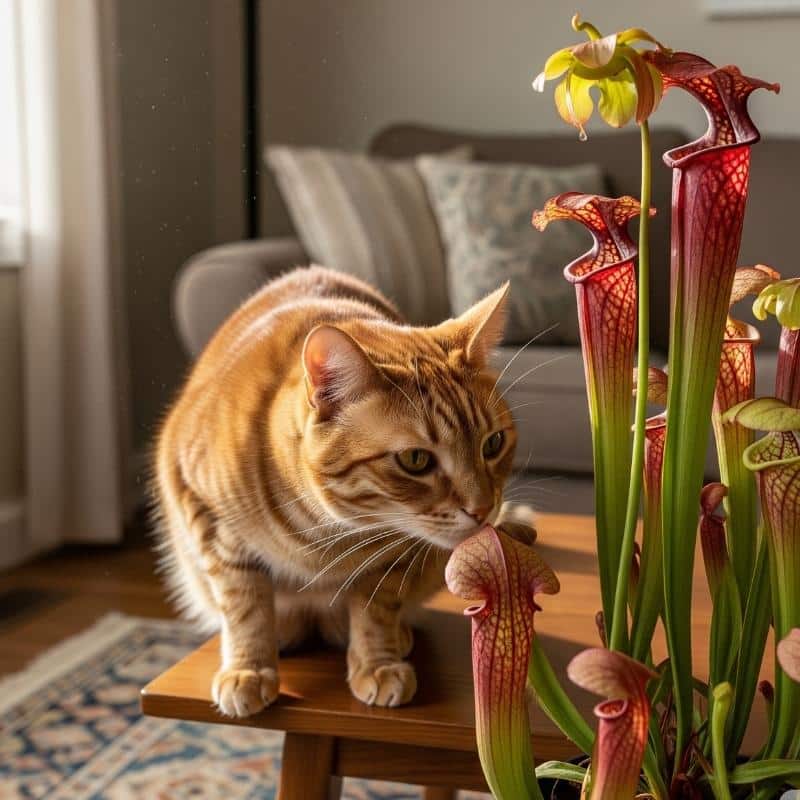
The liquid inside the pitchers contains digestive enzymes, but these are usually only active within the pitcher itself and are generally not harmful if a small amount is licked or ingested by a curious pet. The plant material itself isn’t known to be highly poisonous.
While they are not considered severely toxic, it’s always wise to discourage pets from chewing on any houseplant. Ingesting plant material could still cause a mild upset stomach, vomiting, or irritation. So, it’s recommended to keep Pitcher Plants out of reach of curious pets and small children to prevent any potential discomfort or choking hazards. If you think your pet has eaten a large quantity of plant material or is showing severe symptoms, please contact your veterinarian immediately for advice.
Pitcher Plant for Home Decor: Fascinating Conversation Starter
They are truly a unique choice for home decor, guaranteed to grab attention and spark conversation!
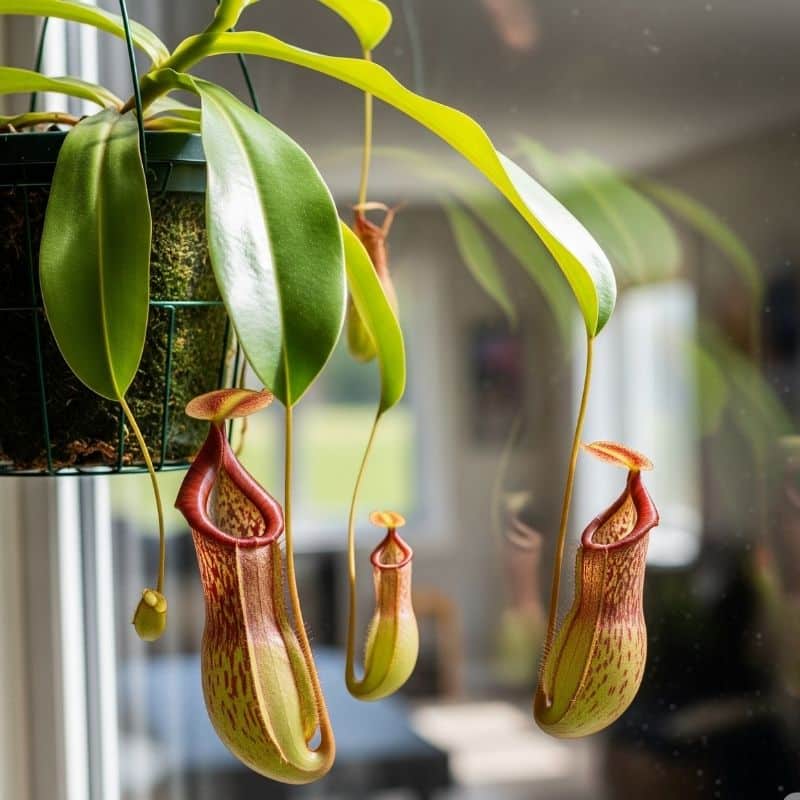
Creating a Unique Display
Since they’re so unusual, Pitcher Plants beg for creative display! You can nestle Tropical Pitcher Plants (Nepenthes) in hanging baskets to show off their dangling pitchers, or display them in open terrariums (making sure they get good airflow). North American Pitcher Plants (Sarracenia) look amazing in outdoor bog gardens or large, self-watering containers.
A Living Science Experiment
For anyone who loves nature or science, a Pitcher Plant is like having a living, breathing experiment right in your home. Watching it lure, catch, and digest insects is incredibly educational and endlessly fascinating.
Adding Exotic Flair
With their alien-like shapes, vibrant colors, and unique carnivorous nature, Pitcher Plants bring a truly exotic and mysterious flair to any room. They’re perfect for creating a distinct focal point that sets your plant collection apart.
The Allure of Pitcher Plants: Mysterious, Carnivorous, and Captivating
The Pitcher Plant is a truly remarkable addition to any plant enthusiast’s collection. It offers an unbeatable blend of mysterious beauty, a wonderfully carnivorous habit, and a captivating presence that constantly intrigues. While they have specific needs for specialized water and soil, meeting these unique requirements is incredibly rewarding when you see those clever pitchers at work. It’s more than just a plant; it’s a tiny, wild wonder that reminds us of the endless marvels of the natural world, bringing a touch of the extraordinary right into your home.
Frequently Asked Questions (FAQ) About Pitcher Plants
Still have some questions about these amazing carnivorous plants? Here are some common ones that might help you out!
Q1: Do Pitcher Plants eat mosquitoes?
A1: Yes, they can! Pitcher Plants (both tropical and North American types) will catch mosquitoes, flies, gnats, and other small insects that fall into their traps. They’re not a complete pest control solution, but they definitely help!
Q2: What kind of water do Pitcher Plants need?
A2: This is CRUCIAL: Pitcher Plants need only distilled water, reverse osmosis (RO) water, or collected rainwater. Tap water contains minerals that will build up in their special soil and kill them.
Q3: Do I need to feed my Pitcher Plant insects?
A3: No, you don’t need to force-feed them! If they’re outdoors or you have a few bugs around your house, they’ll catch their own. They can survive perfectly fine indoors without catching insects, especially if they get good light. They just won’t grow as vigorously as if they were getting regular insect meals.
Q4: Why are my Pitcher Plant’s pitchers turning brown and shriveling?
A4: This is a common issue! For tropical Nepenthes, it’s often due to low humidity, not enough light, or using tap water. For Sarracenia, it could be a lack of sun, improper watering, or simply the natural dieback before dormancy. Ensure correct water, light, and humidity (for Nepenthes).
Q5: Can I use regular potting soil for my Pitcher Plant?
A5: Absolutely NOT! Using regular potting soil will quickly kill your Pitcher Plant. They need nutrient-poor, acidic soil like long-fiber sphagnum moss, peat moss, or perlite/horticultural sand.
Q6: Is the liquid inside the pitcher dangerous?
A6: The liquid inside the pitcher contains digestive enzymes. While it’s not a good idea to drink it, it’s generally not considered dangerous to humans or pets in small amounts. It won’t “burn” your skin.
Q7: Do Pitcher Plants need high humidity?
A7: Tropical Pitcher Plants (Nepenthes) yes, absolutely! They thrive in high humidity (70%+ is ideal). North American Pitcher Plants (Sarracenia) don’t need extremely high air humidity, but they do need their soil to be constantly wet.
Q8: Are Pitcher Plants safe for pets?
A8: Pitcher Plants are generally regarded as non-toxic to mildly toxic for pets. While the digestive enzymes aren’t severely harmful in small amounts, it’s always best to discourage pets from chewing on plants to prevent an upset stomach.
Q9: How do I get my Sarracenia (North American Pitcher Plant) to go dormant?
A9: Sarracenia needs a cold winter dormancy to survive long-term. As temperatures drop in fall, reduce watering. Move the plant to a cool spot (35-50°F / 2-10°C), like an unheated garage or porch, for 3-4 months. Its pitchers will die back, but the rhizome will rest and re-emerge in spring.

